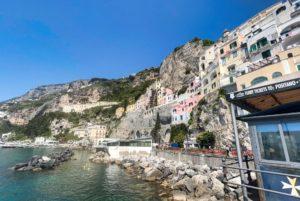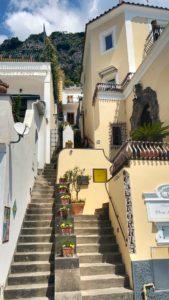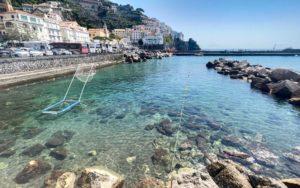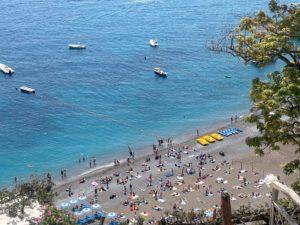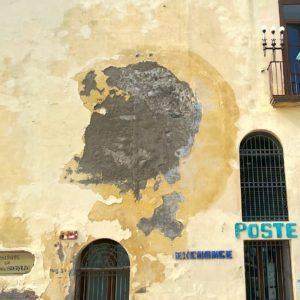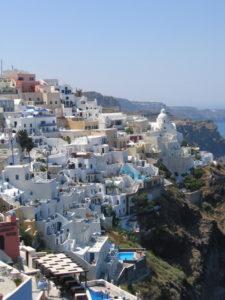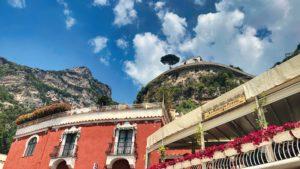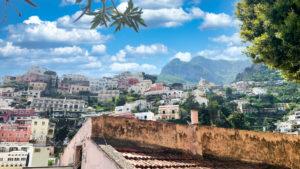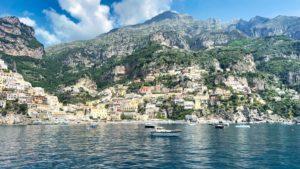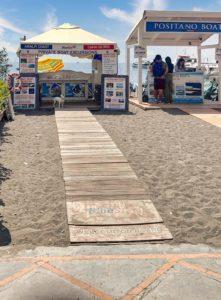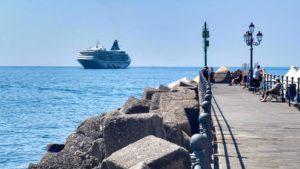Positano Italy is kinda like the Paris Hilton or Kim Kardashian of Italy's Amalfi Coast towns. By that, I mean, the place is inarguably good-looking, yet it doesn't seem to possess much in the way of substance. Where's the casino, strip club, or Ripley's Believe It Or Not®? Personally, I think Positano has just been getting by on its looks. And I bet it's lazy in the sack.
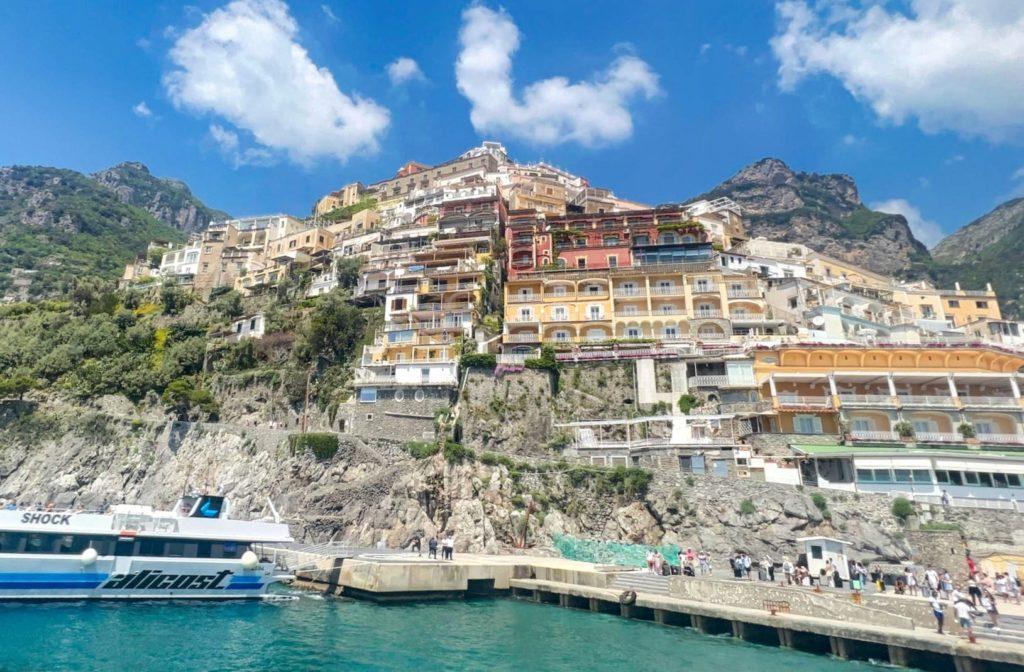
Positano Italy is located just around the bend from Amalfi.
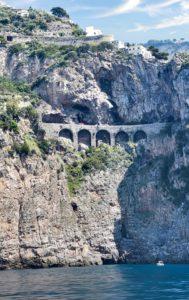
Even though Positano is only 10 miles away from our Airbnb in Amalfi, the trip there from Amalfi wasn't insignificant. We could've driven, but the single-lane road that runs along the water's edge, which connects all of Italy's Amalfi Coast can be a parking lot during high season.
To make matters worse, cab prices are practically punitive. If you want someone else to drive you around Amalfi, it's going to cost you an arm, a leg, and two other body parts of your choosing (I'd recommend your appendix and tail-bone).
The best way to get around the Amalfi Coast is, undoubtedly, by water. Literally any aqueous mode of transport is better than a car—kayak, paddle board, dolphin-back, hovercraft, you name it. Wheeled transport is only for suckers and aquaphobics.
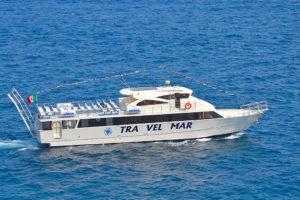
Luckily, the large Travelmar ferry boats—or their smaller, faster shuttles—make regular trips to all the port towns between Salerno and Positano. For a very reasonable €9.00 (~US$9.00), you can just climb aboard one and enjoy a pleasant and relaxing sail on the Mediterranean Sea.
After cruising past 10-miles of coastal cliffs—a trip which took about twenty minutes, in total—our ferry boat docked and dropped us off at one of the world's most photo-friendly towns: Positano Italy.
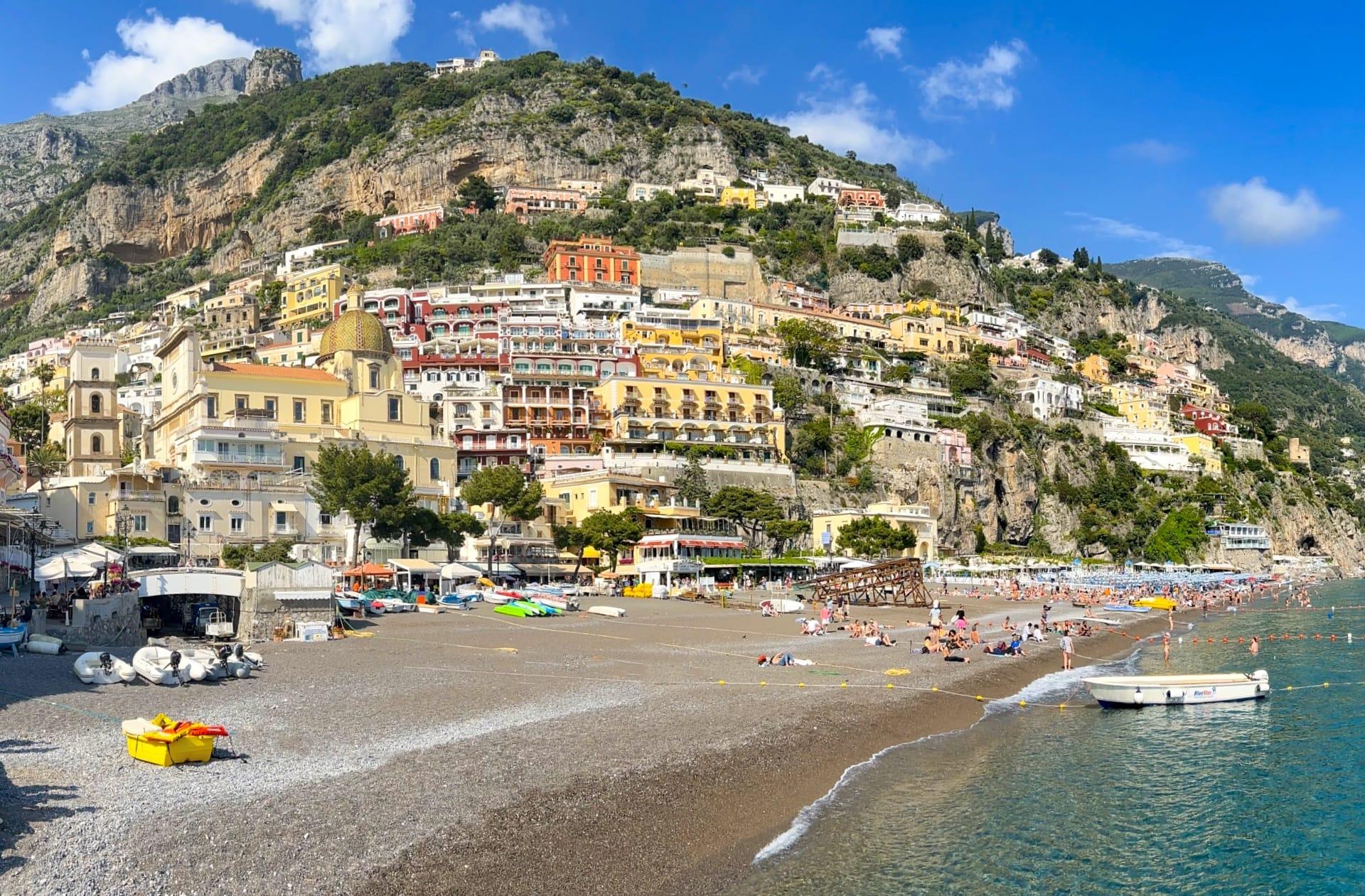
Positano Italy is the Instagram capital of the world.
If you've ever spent 30-seconds on Instagram—and that's about as much as I can stand—the village of Positano Italy will be instantly recognizable. That's because there are over 2.5M photos of the place posted by “influencers” hoping to one day become actual celebrities.
Yet, it's not hard to see why there are so many pics of the place—it is undeniably spectacular-looking. Almost the polar opposite of filthy Naples. Especially if you've recently been to Amalfi, Positano's less polished, but more authentic-looking, next-door neighbor.
Like every town along Italy's Amalfi Coast, Positano is a village on a vertical axis, wedged into a natural, hilly ravine between the cliffs along the coast.
Similarly, Positano's narrow streets also slope steeply down to a wide, gray beach made of piccolo pebbles. It doesn't differ, structurally, that much from Amalfi either.
“Positano” likely comes from the Latin word, “pausa” meaning “place to chill out, bro.”
#paraphrasing
However, unlike the coast's titular town—whose buildings were apparently last painted in the 1300s—Positano's houses and buildings are more recently painted entirely in cheery, non-chipped pastels. And the difference is noticeable.
As a result of painting and power-washing the town every 1,000 years or so, this idyllic town was understandably nicknamed, “The Gem of the Divine Coast.”
In fact, Positano is so outwardly appealing that it could almost double for the stunning island of Santorini, assuming you have achromatopsia, and don't actually speak Greek to any of the locals (they'll look at you funny).
The Paleolithic past of Positano Italy.
Positano hosted Homo sapiens as far back as 50,000 BCE when the numerous caves and grottoes formed in its cliffs were visited by Stone Age Yelp-reviewers who rated them “Dark and damp, wet floors, good fishing, but no protection from Neptune's wrath, would not recommend: 3-stars.”

The first evidence of human settlement here goes back to the first century B.C.E., when Ancient Romans occasionally took a break from subjugating Ancient Greeks. They likely vacationed in Positano due to its beautiful landscape, mild temperatures, and Centurions-Eat-Free restaurant promotions.

During the Middle Ages (500-1500CE), Positano's merchants dominated Mediterranean trade in the 9th and 10th centuries. But during the 1400s, the town was visited repeatedly by the only thing worse than tourists: Pirates and Plagues.
Positano Italy eventually recovered and roared back again during the 16th and 17th centuries, trading spices and silks with Middle Eastern countries. They completely dominated the global market for cumin pajamas, cardamom robes, and anise sheets.

Yet by the 19th Century, Positano had unwillingly returned to its roots as an impoverished fishing village. Nearly half of its citizens immediately immigrated to America, the land of seafood-free opportunity. They quickly found work in mining and manufacturing, but racism pretty much everywhere else. Meanwhile, back in Positano, trust-fund foreigners started showing up looking for short-term shelter, street cafés, and souvenirs.
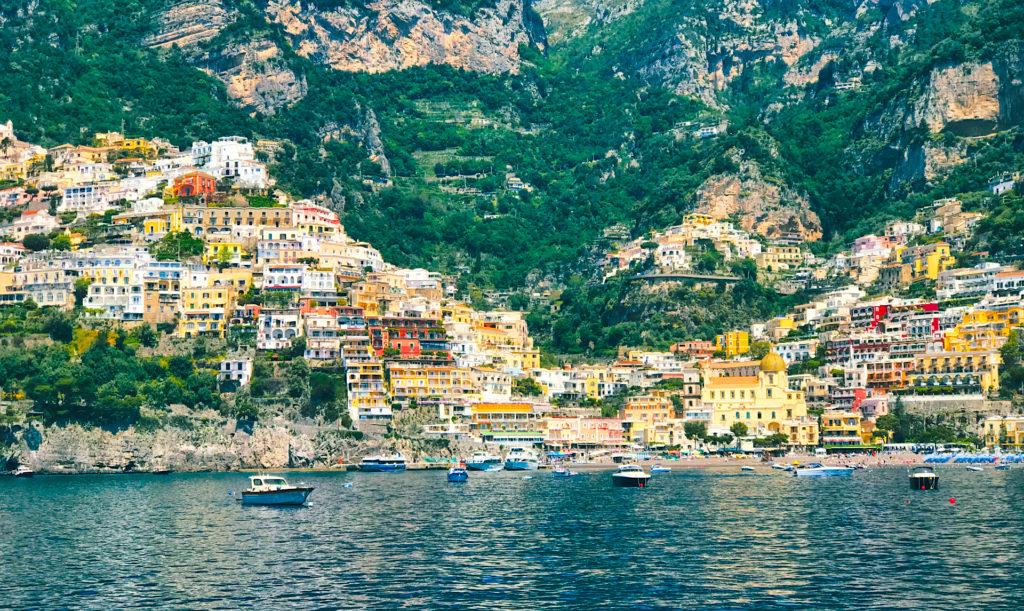
Positano tarts itself up, and whores itself out.

Tourism is by far Positano's biggest industry, even larger than lemon growing. Yet, tourism didn't really blow up until after the Second World War (when everything else stopped blowing up). Peace returned to Italy when all its fascists were rounded up and “purged” by hanging their dead bodies upside down in Milan for a while.
With the “Mussolini & Friend's Fascist Fantasyland” naught but a distant memory, Positano Italy became a popular holiday destination for international jet-setters thanks to its more appealing temperate climate and its less murderous political climate.

Throughout the '50s, '60s, and '70s, Positano was frequented by royalty, politicians, artists, and celebrities like Jackie Kennedy, John Steinbeck, and Liz Taylor. Less famous people came to Positano, too, but do you really care about them? Of course not. No one does.
As the town's popularity rose, its artisan community began to flourish. These days, Positano is famous for its manufacture of quality ceramics and leather goods, breezy linen and light-cotton fashions, as well as its outrageous pricing—come on, $110 for a freakin' hat…?!?
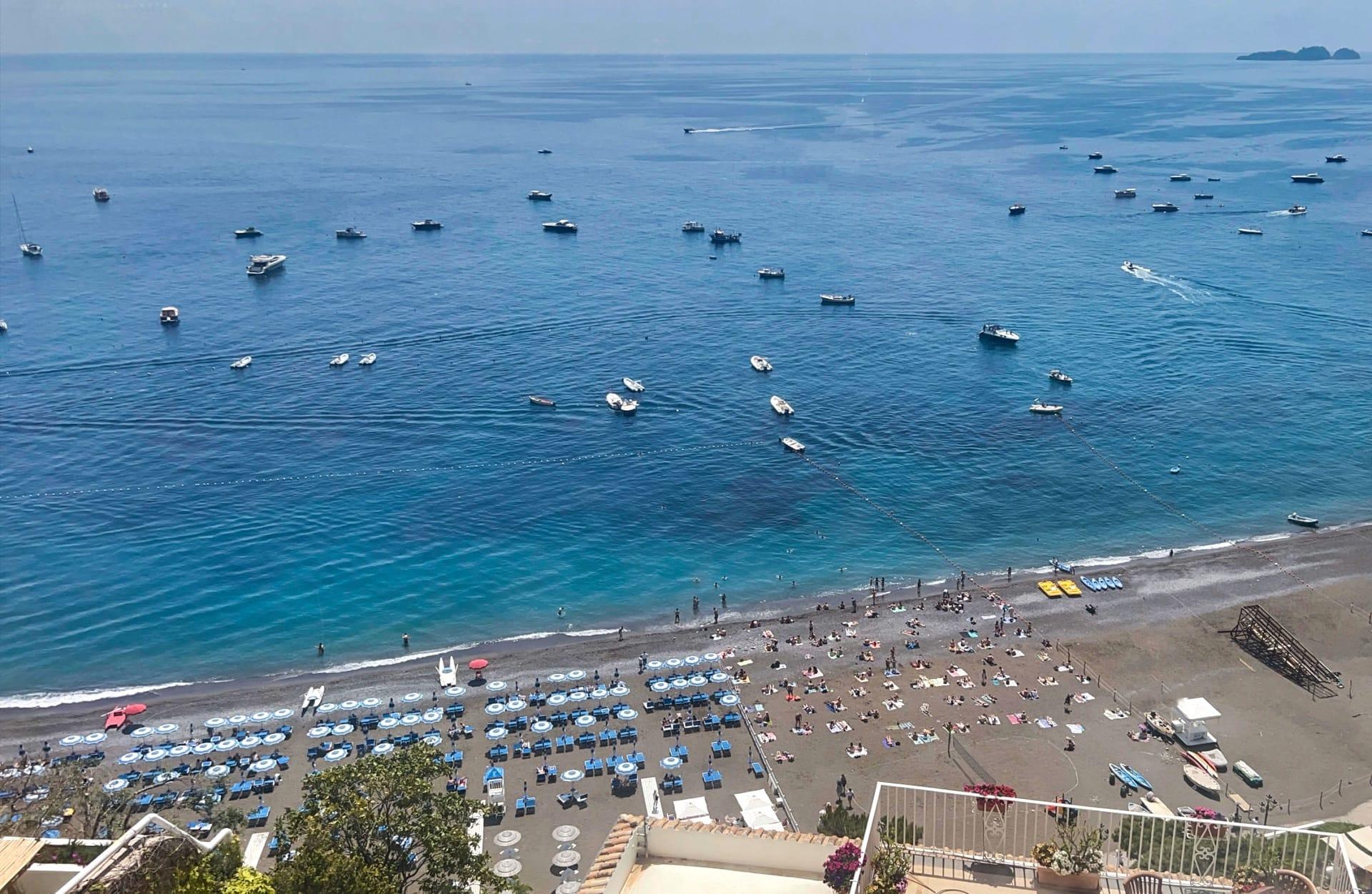
One picturesque place to eat in Positano.

After disembarking from the ferry, we walked all around Positano proper. We found nothing at ground level except the aforementioned over-priced shops and restaurants.
So we went hiking up the hill for a higher vantage point and, we hoped, lower prices. At the top of town, we came across the “Acquisto” restaurant located on a ridge just outside the Hotel L'Ancora.
This casual Italian place offered outdoor seating and a nice, panoramic view down to the water (see photo). More importantly, we were hungry and tired, and the Acquisto was…you know, there.
Surprisingly, the food was excellent. In fact, it may have been the best Cannelloni of my entire life. And that's really saying something, considering that I've been to authentic Italian bistros like the Olive Garden and Romano's Macaroni Grill.

Positano Italy exists solely as a seaside tourist magnet.
Despite both its natural and architectural beauty, Positano nonetheless feels less like a town where people live and work, and more like an outdoor mall where tourists shop and take selfies. The place is just overly cheerful and charming.
Frankly, the town seems like a DisneyWorld® knock-off of itself—it's so sanitized and storybook that if Mickey Mouse® showed up in a Speedo®, you wouldn't even bat an eye.
Admittedly, Positano does look a lot better than Amalfi. Mostly because it has enough money in the town budget to repaint every millennium or so. (Zing! Take that, hue-hating Amalfi!)
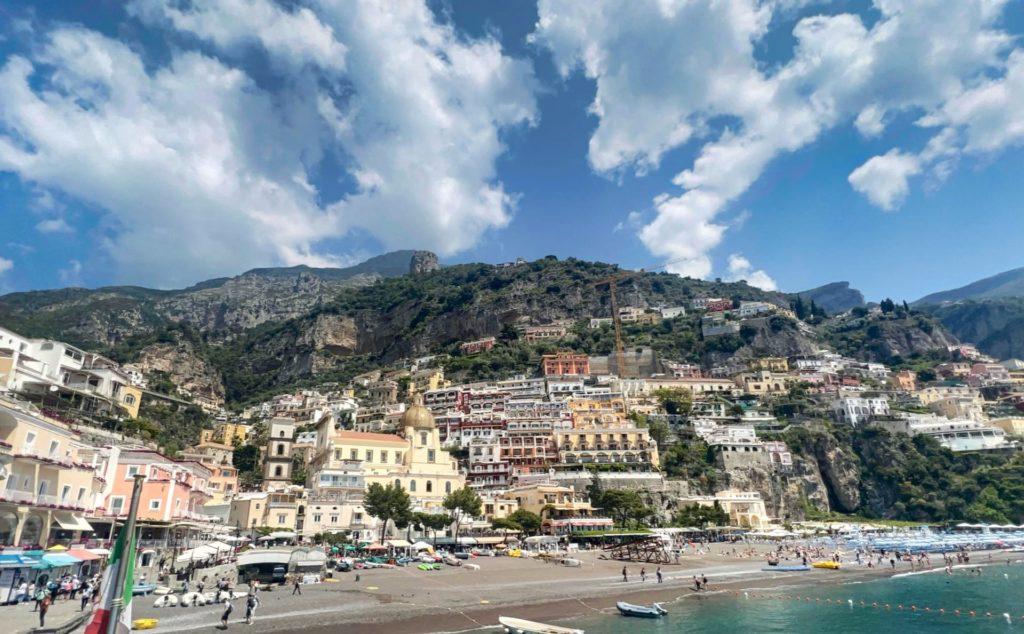
Sure, Positano is pretty, but looks aren't everything.
Look, I get it, fishing is a really smelly way to make a living. So it's no surprise that the people of Positano welcomed the Devil You Know (i.e., foreigners with disposable income).
But preserving the village's future through tourism came at a high cost—namely, its soul. The town's rapid growth from a charmingly destitute fishing village to a pricey tourist destination has kinda ruined this place.
Despite being over two thousand years old, Positano no longer feels very authentic as a medieval village—I mean, it has electricity almost everywhere. Yet, by far, the worst aspect of Positano is its inducement of people like me to visit. And, I can promise you, the place was in no way better off for it.
Read more about specific towns along Italy's Amalfi Coast:
- Naples, Italy
- Amalfi, Italy
- Positano, Italy
- Ravello, Italy (pending)
- Sorrento, Italy (pending)
- Capri, Italy (pending)

